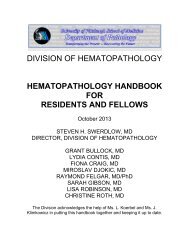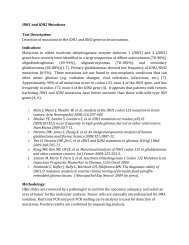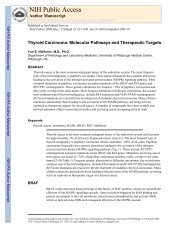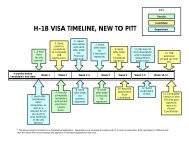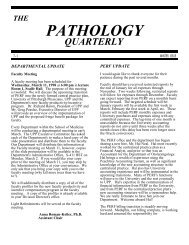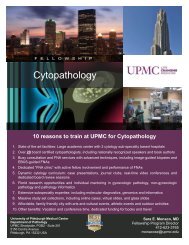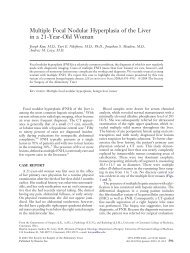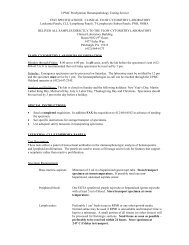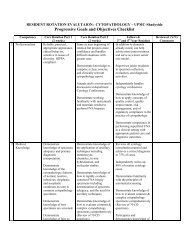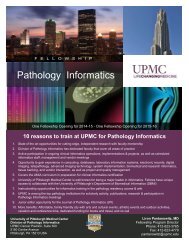Topological basis of signal integration in the transcriptional ...
Topological basis of signal integration in the transcriptional ...
Topological basis of signal integration in the transcriptional ...
You also want an ePaper? Increase the reach of your titles
YUMPU automatically turns print PDFs into web optimized ePapers that Google loves.
BMC Bio<strong>in</strong>formatics 2006, 7:478<br />
http://www.biomedcentral.com/1471-2105/7/478<br />
score: 2.2) to <strong>the</strong> distribution deduced from <strong>the</strong> sets A\B<br />
and B\A summed toge<strong>the</strong>r (see Methods for details). Thus,<br />
we <strong>in</strong>fer that <strong>in</strong> <strong>the</strong> TR network <strong>of</strong> S. cerevisiae overlapp<strong>in</strong>g<br />
pairs <strong>of</strong> origons significantly <strong>in</strong>tegrate regulatory tasks.<br />
<strong>Topological</strong> organization <strong>of</strong> <strong>signal</strong> <strong><strong>in</strong>tegration</strong> <strong>in</strong> <strong>the</strong> yeast<br />
TR network<br />
Complex environmental <strong>signal</strong>s are decomposed <strong>in</strong>to<br />
more elementary <strong>signal</strong>s that eventually elicit an <strong>in</strong>tegrated<br />
<strong>transcriptional</strong> response <strong>in</strong> <strong>the</strong> context <strong>of</strong> <strong>the</strong> cell's<br />
own <strong>in</strong>ternal state. S<strong>in</strong>ce <strong>in</strong>termediate TFs (by def<strong>in</strong>ition)<br />
transmit <strong>signal</strong>s from <strong>in</strong>put to output nodes and provide<br />
connections among all TFs (Fig. 1A), <strong>the</strong> topological<br />
organization <strong>of</strong> <strong>the</strong>ir <strong>in</strong>teractions is likely to play a key<br />
role <strong>in</strong> develop<strong>in</strong>g such <strong>in</strong>tegrated responses. To exam<strong>in</strong>e<br />
<strong>the</strong>ir relationships, we decomposed <strong>the</strong> TR network by an<br />
iterative peel<strong>in</strong>g algorithm (see Methods), where <strong>the</strong> top<br />
and bottom layers <strong>of</strong> <strong>the</strong> network have been successively<br />
removed until only 3 small isolated graph components<br />
('cores') rema<strong>in</strong>ed. Then <strong>the</strong>se cores were consolidated by<br />
add<strong>in</strong>g back <strong>the</strong>ir nearest up- and downstream <strong>in</strong>termediate<br />
regulators (Fig. 3A). After this decomposition procedure<br />
we found that <strong>the</strong> 45-node <strong>in</strong>termediate TF<br />
subnetwork naturally segregated <strong>in</strong>to three <strong>in</strong>ternally<br />
densely-connected groups <strong>of</strong> TFs (referred to as 'organizer'<br />
O1, O2, and O3 hereafter), as well as several isolated TF<br />
nodes (Figs. 3A,B). In contrast, <strong>the</strong> connections between<br />
organizers are sparse (Fig. 3B): organizers O1 and O2 are<br />
connected by one <strong>in</strong>teraction (between Nrg1 and Hap4),<br />
and O2 and O3 have only two connections (Fkh1-Yhp1<br />
and Abf1-Put3). Of note, all three <strong>in</strong>ter-organizer connections<br />
transfer a <strong>signal</strong> from <strong>the</strong> 'top' (as def<strong>in</strong>ed by <strong>the</strong><br />
flow <strong>of</strong> <strong>in</strong>formation) <strong>of</strong> one organizer to <strong>the</strong> 'bottom' <strong>of</strong><br />
<strong>the</strong> o<strong>the</strong>r. We also f<strong>in</strong>d that <strong>in</strong>put TFs <strong>of</strong>ten co-regulate<br />
<strong>in</strong>termediate TFs located <strong>in</strong> one or two organizers, but<br />
never <strong>in</strong> all three <strong>of</strong> <strong>the</strong>m. Note, that as an alternative<br />
approach we also performed computational search for<br />
partially overlapp<strong>in</strong>g communities [27] <strong>in</strong> <strong>the</strong> TR network.<br />
This analysis yielded highly similar results (Supplementary<br />
Fig. S3), suggest<strong>in</strong>g that <strong>the</strong> concept <strong>of</strong> organizers<br />
is valid irrespective <strong>of</strong> data str<strong>in</strong>gency (Supplementary Fig.<br />
S4), or <strong>the</strong> analytical technique used for <strong>the</strong>ir identification.<br />
Currently, on <strong>the</strong> global scale <strong>the</strong> dynamical utilization <strong>of</strong><br />
<strong>signal</strong>-specific transcription regulatory subnets can be best<br />
tested with microarray expression data [12,13]. To analyze<br />
<strong>the</strong> dynamical role <strong>of</strong> organizers, for each <strong>of</strong> <strong>the</strong> 45 <strong>in</strong>termediate<br />
TFs we have def<strong>in</strong>ed <strong>the</strong> TF and <strong>the</strong> list <strong>of</strong> its targets<br />
as a group <strong>of</strong> genes, and computed <strong>the</strong> <strong>transcriptional</strong><br />
response <strong>of</strong> this group to a given external or <strong>in</strong>ternal <strong>signal</strong><br />
(see Methods). Under hyperosmotic shock (Fig. 3C), <strong>the</strong><br />
TFs (and <strong>the</strong>ir target genes) <strong>in</strong> organizer O2 displayed by<br />
far <strong>the</strong> strongest average response, as measured by <strong>the</strong><br />
double Z score [13] (see Methods): 0.8, compared to -0.13<br />
and -0.14 <strong>in</strong> organizers O1 and O3, respectively. With<strong>in</strong><br />
this group <strong>the</strong> set <strong>of</strong> genes regulated by <strong>in</strong>termediate TFs<br />
Hap4, Sok2, Phd1, and Rox 1 show <strong>the</strong> strongest<br />
response. All <strong>the</strong>se TFs are regulated by <strong>in</strong>put TF, Skn7,<br />
suggest<strong>in</strong>g that this <strong>in</strong>put TF is one <strong>of</strong> <strong>the</strong> ma<strong>in</strong> sensors <strong>of</strong><br />
hyperosmotic shock <strong>in</strong> S. cerevisiae, <strong>in</strong> agreement with previous<br />
results [28]. A similar conclusion can be drawn for<br />
all o<strong>the</strong>r environmental stimuli tested (Supplementary<br />
Fig. S5), suggest<strong>in</strong>g that only a subnet <strong>of</strong> organizer(s) are<br />
activated upon simple or complex environmental stimuli.<br />
Discussion<br />
The multitude <strong>of</strong> cellular tasks makes it necessary for cellular<br />
components to be hierarchically organized <strong>in</strong>to<br />
modules based on functional association [29]. One wellstudied<br />
aspect <strong>of</strong> this functional organization is <strong>the</strong> 'static<br />
map' <strong>of</strong> a TR network, i.e., <strong>the</strong> list <strong>of</strong> all possible transcription<br />
regulatory (TR) <strong>in</strong>teractions with<strong>in</strong> a cell. Small numbers<br />
<strong>of</strong> <strong>in</strong>dividual TR nodes (TFs and <strong>the</strong>ir regulated<br />
genes) are known to be arranged <strong>in</strong>to overrepresented,<br />
specifically wired <strong>in</strong>formation process<strong>in</strong>g units (motifs)<br />
[8], which <strong>in</strong> turn participate <strong>in</strong> a series <strong>of</strong> sequentially<br />
embedded higher order structures [9,10]. In an actual<br />
response, however, from all topological (static) possibilities<br />
<strong>in</strong> <strong>the</strong> TR network <strong>the</strong> cell utilizes only limited sets <strong>of</strong><br />
<strong>the</strong>se <strong>in</strong>teractions [12]. These <strong>in</strong>teractions are <strong>of</strong>ten <strong>signal</strong>specific<br />
[13], though <strong>the</strong>re are also many TR nodes that are<br />
known to be generic responders [12].<br />
However, TR <strong>in</strong>teractions represent only a subset <strong>of</strong> regulatory<br />
<strong>in</strong>teractions. In fact, prote<strong>in</strong>-prote<strong>in</strong>- and prote<strong>in</strong>metabolite<br />
<strong>in</strong>teractions represent <strong>the</strong> majority <strong>of</strong> <strong>in</strong>formation<br />
process<strong>in</strong>g <strong>in</strong>teractions <strong>of</strong> a cell (Fig. 4). When tak<strong>in</strong>g<br />
this <strong>in</strong>to account, additional heterogeneous <strong>in</strong>teraction<br />
patterns can be uncovered at various hierarchical scales<br />
[10,30]. Never<strong>the</strong>less, TR <strong>in</strong>teractions represent <strong>the</strong> 'slow<br />
component' <strong>of</strong> <strong>the</strong> overall network, whose behavior determ<strong>in</strong>es<br />
long-range response [1-3]. Thus, it is <strong>of</strong> great<br />
importance to understand how <strong>the</strong> large-scale structure <strong>of</strong><br />
a TR network reflects <strong>the</strong> <strong><strong>in</strong>tegration</strong> <strong>of</strong> <strong>the</strong> vast variety <strong>of</strong><br />
<strong>in</strong>dividual external <strong>signal</strong>s with each o<strong>the</strong>r and with <strong>the</strong><br />
cell's <strong>in</strong>ternal state.<br />
Detailed methods, a supplementary table and supplementary<br />
figures are also available [see Additional file 1].<br />
Conclusion<br />
From <strong>the</strong> analyses presented here <strong>the</strong> system-level picture<br />
aris<strong>in</strong>g for <strong>the</strong> <strong><strong>in</strong>tegration</strong> <strong>of</strong> TR <strong>signal</strong>s suggests <strong>the</strong> presence<br />
<strong>of</strong> a small number <strong>of</strong> large-scale <strong>signal</strong> <strong><strong>in</strong>tegration</strong><br />
'pools' (organizers) <strong>in</strong> <strong>the</strong> yeast TR network, along which<br />
<strong>signal</strong>s are processed and transmitted towards all target<br />
genes (Fig. 4). Regulatory connections <strong>in</strong>side organizers<br />
are dense, while <strong>in</strong>ter-organizer connections are sparse. In<br />
addition to this topological separation, <strong>the</strong> target genes <strong>of</strong><br />
Page 6 <strong>of</strong> 12<br />
(page number not for citation purposes)



